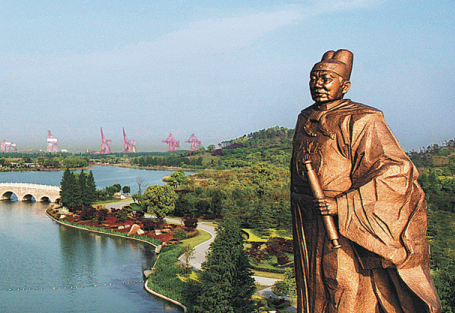Was the place where Chinese monk Jianzhen set off on his sixth voyage to propagate Buddhism in Japan
Located where the Yangtze River meets the sea, Suzhou has strengthened its role in developing cultural exchanges, which it has done since ancient times.
Zheng He, a famed navigator during the Ming Dynasty (1368-1644), set off from Liujiagang in Taicang, now a county-level city governed by Suzhou, with a fleet of ships seven times between 1405-33 to the western Pacific and the Indian Ocean. He and his team visited more than 30 countries and regions across Asia and Africa.
His voyages helped to establish friendly relations and promoting economic and cultural exchanges between China and countries in Southeast Asia, India, the Middle East and East Africa, according to the Suzhou city government.
To honor Zheng, the Taicang government built a park covering 122 hectares at the Yangtze River. There, an 18-meter-tall bronze statue of him overlooks the river.
"Every time Zheng set off from Taicang, he recruited followers and prepared materials before departure," said Jiang Hui, curator of the Zheng He Memorial Hall in the park.
"The openness and pioneering spirit of Zheng has been passed on in Taicang," Jiang said.
Suzhou's historical role in connecting with the outside world is also shown in the Huangsipu ruins, which was a top 10 archaeological discovery in China in 2018.
The ruins, including chinaware, a stone Buddha, and temple buildings, provided evidence that the site, located in Zhangjiagang, a part of Suzhou, was a flourishing port at the Yangtze River from the Tang Dynasty (618-907) that served foreign trade.
It also led archaeologists to suspect it was where Chinese monk Jianzhen set off on his sixth voyage to propagate Buddhism in Japan during the Tang Dynasty. His move promoted cultural exchanges between ancient China and Japan.
Now Suzhou is working to set up a platform to protect the Yangtze River, better inherit the culture accumulated for thousands of years, and promote the development of fine traditional culture.

One of the efforts is to hold an annual cultural festival in Zhangjiagang, highlighting the heritage preservation and inheritance along the river. The annual event started in 2004.
This year's festival will be held in Zhangjiagang from Saturday until the end of October. Representatives from 13 provincial regions in the river basin, including Tibet autonomous region at the headstream to Shanghai at the estuary, are expected to participate.
In addition to a gala for displaying Yangtze culture, the festival aims to be a party for local people. It is to hold 10 main activities, including seminars, exhibitions and performances, both online and offline, during the next two months.
Related articles
-
 Rare cliff carving Buddhist statues found in Tibet
Rare cliff carving Buddhist statues found in TibetMore
-
 Monks unfurl giant artworks as Shoton begins
Monks unfurl giant artworks as Shoton beginsMore
-
 Zen masters' influence across globe
Zen masters' influence across globeMore
-
 Panchen Rinpoche carries out head-touching ritual to bless religious believers
Panchen Rinpoche carries out head-touching ritual to bless religious believersMore
-
 13 monks receive doctoral degree equivalent in Tibetan Buddhism
13 monks receive doctoral degree equivalent in Tibetan BuddhismMore
-
 Repairing the past, restoring our future
Repairing the past, restoring our futureMore
